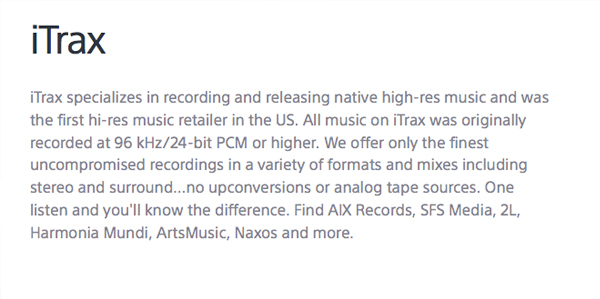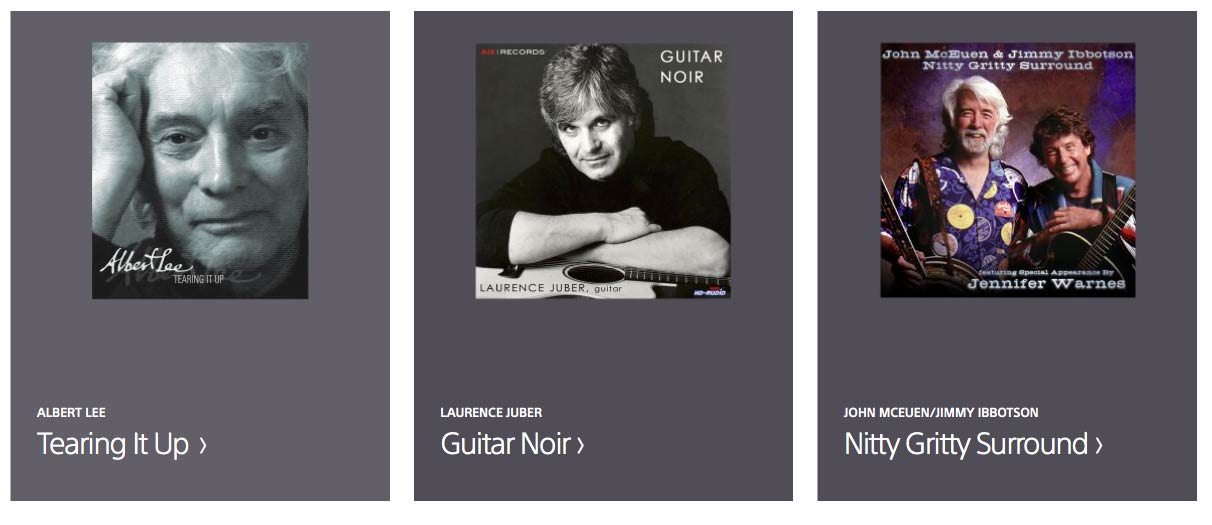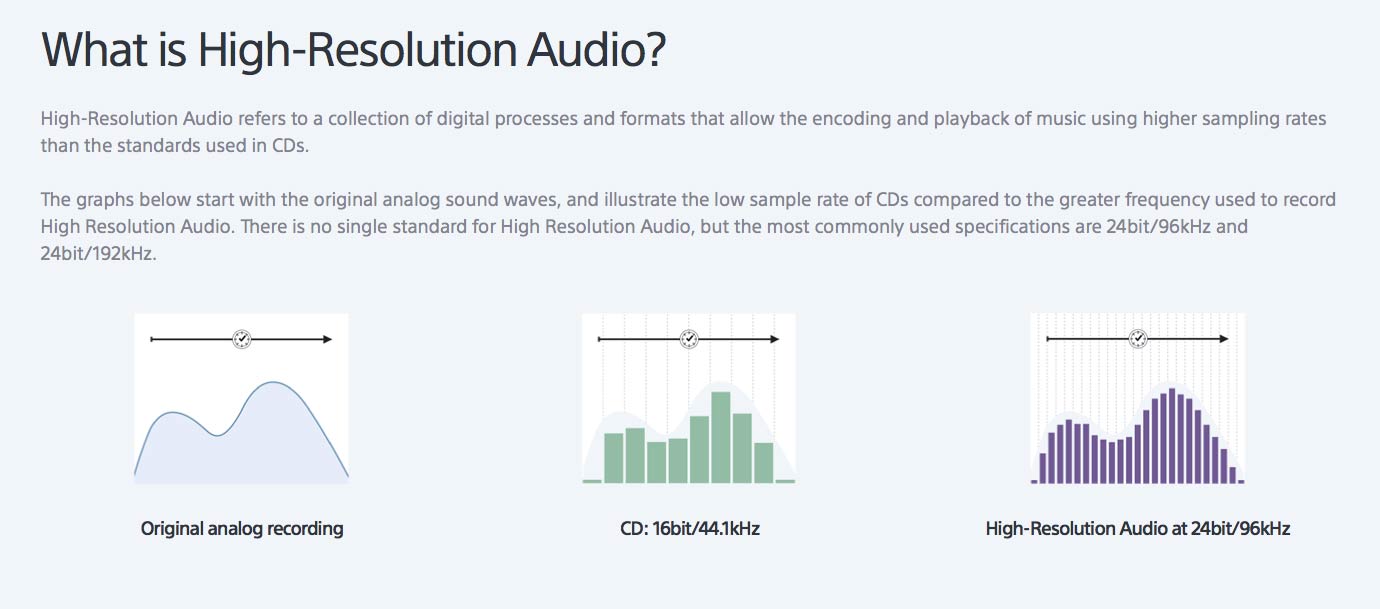Digital Audio Basics: Lose The Stairsteps
The marketing people at Sony let me know that their new website designs have launched. They passed along two URLs that deal with high-resolution audio. The first features their entire line of hardware and some discussion about high-resolution audio. Click here to visit this new Sony site. The second focuses on sites that offer “high-resolution audio” content…or as the DEG, NARAS, and labels now call it “high-resolution music”. This continuing confusion of terminology is not going to make the subject any clearer. Click here to take a look at the content site.
I’m very pleased that Sony included iTrax in their list of places to acquire high-resolution music. In addition to my site, you’ll find a number of other digital music download sites. There’s ProStudioMasters, SuperHiRez, Blue Coast Records, Native DSD Music, Linn Records, Naim Label, and 2L. Notable omissions include HDtracks and PonoMusic. I can only guess why these services, admittedly the largest sites offering high-res transferred music, are included on the new Sony site. Maybe…just maybe…the chose to feature sites that are offering new recordings made using high-resolution audio equipment. Although, that would rule out the ProStudioMasters site, which is a basically a copy of HDtracks’ offerings. They sell the same catalog of major label content that has been transferred to big bit buckets as the other two.
Figure 1 – The section of the Sony site that highlights itrax. These are covers from some of our most popular and best sounding albums. [Click to enlarge]
I may have issues with Sony’s DSD technology and marketing push, but I’m very grateful that they are tilting to the right concept of new recordings. But the other site has the dreaded “resolution” comparison chart. You know the one…I’ve copied it below:
Figure 2 – A chart from the new Sony high-resolution audio website showing the relative qualities/resolutions of audio in CD-res and High-Res. [Click to Enlarge]
Why this type of chart continues to be used is a mystery (although I admit I’ve used similar graphics in the past and on this site…sorry). I even mentioned that this could be embarrassing…but there it is. What’s wrong with this image? It does seem to make sense on a simplistic level. An analog signal is nice and smooth…it’s a continuously variable analog audio signal. The images with the vertical slices and the icon of a clock are meant to show how the higher 96 kHz/24-bit system is visually more similar to the analog original than the CD res illustration.
Each digital representation uses vertical bars to show the energy available at each sample. They should be instead points of amplitude. At each sample, the vertical bars in the diagram, the amplitude value is measured. The closest available amplitude value (among the 65K or 17K available discrete values available) is then stored. These are the only values we know about in a digital conversion of an analog signal. An actual diagram is equally compelling.
I’ll show you an example tomorrow…got to make some more progress on the newsletter that I’m preparing. It’s all about the “Music and Audio” book.
To be continued…




So, what is the sampling frequency in essence? Sampling the sound with 44.1kHz means that the CD can “differentiate the sound up to 25 microseconds.” Raising the sampling frequency to 96kHz, for example, should not be considered as an extended frequency range up to 48kHz; it should be regarded as an “enhanced precision – over time domain,” instead.
Hi Mark
I’m in full agreement with Jay concerning the issue of sampling frequency, which assumes that sampling at 96 kHz raises the FR to 48 kHz. Which also brings into question the need for electronics and especially loudspeakers to have FR beyond 20 kHz for the full effect of HDA to be realized.
Judging from my point of view, with hearing ability that goes to approximately 14 kHz why would it matter if my tweeters extend beyond 20 kHz?
IMO the prime reason for the new spec in the JAS agreement is an increase for hardware manufactures profit margin.
Reuben
The 96 kHz sampling rate does open up additional frequency range…whether that’s important or not is another issue. But there are musical partials above 20 kHz and I believe it’s valuable to capture and reproduce them. Of course, we’re dealing with a true high-resolution capable system. The JAS is right in moving the standard up…the rest of the industry is doing a big spin on the content and hardware.
It is possible that technology could change the human hearing frequency range in the future.
Human response to sound generated at 100kHz has been demonstrated, at least in a controlled underwater anechoic chamber. One suggested explanation for this response is demodulation of the 100kHz signal occurring within the listeners body.
http://archive.rubicon-foundation.org/xmlui/handle/123456789/5124
Enhancements to normal human hearing are being developed. These enhancements could eventually include response to frequencies greater than 20kHz.
And until that day, safely consider it inaudible. Please DO NOT make the massive blunder of trying to post-rationalise what unsighted listening tells you about higher sampling rates being ‘audibly better’. That evidence is entirely and comprehensively demonstrated to be consistent with the known effects of unrolled perceptual testing .
Grant – Sorry for the late reply, but I just discovered that you had replied to my comment about research on human perception of frequencies in the 20kHz – 100kHz range. I never said ‘audibly better’; I provided a link to research demonstrating that a 100kHz signal is audible by humans. This is a quote from the abstract of the article “We hypothesize that non-linearity in the skull, soft tissue, and/or cerebral spinal fluid demodulates the ultrasonic frequencies down into the audible frequency range”. The hypothesis is that ultrasonic frequencies produce frequencies in the “audible frequency range” of sufficient amplitude to be audible. The testing demonstrated that the 100kHz signal was reliably audible by the human test subjects, but like any research finding, it requires corroboration.
As to my comments on enhancements to normal human hearing, simple enhancements such as frequency shifting can be used to hear frequencies above 20kHz. There are many ways to shift frequencies, doppler shifts, digital processing and demodulation within the human skull are all ways ultrasonic frequencies can be made audible.